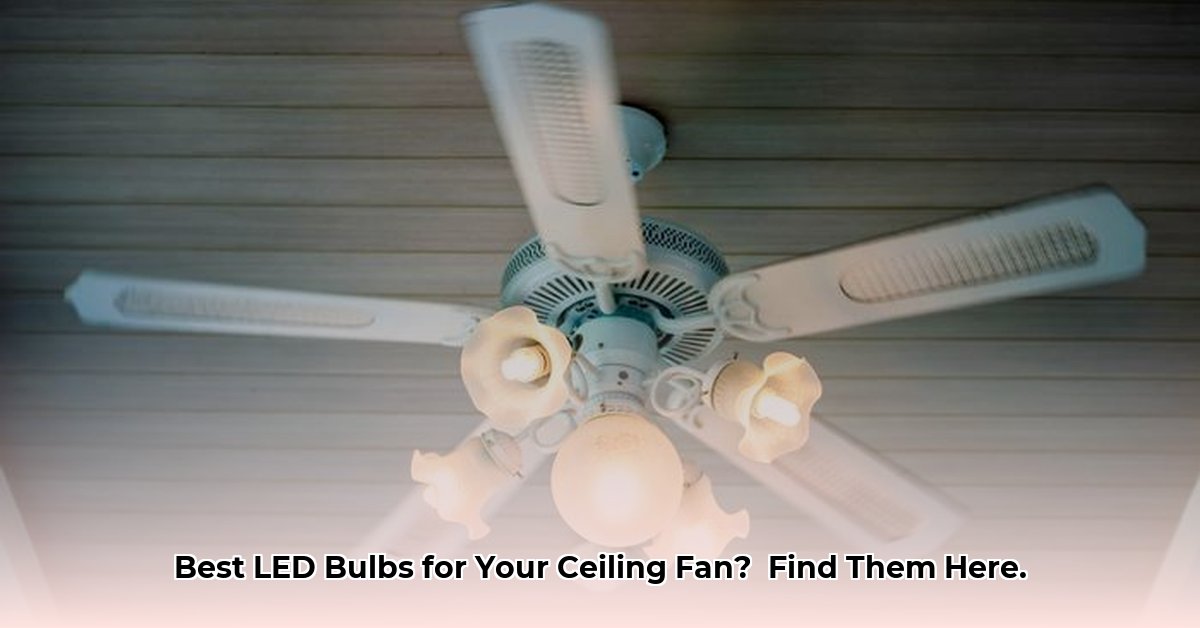Ready to upgrade your ceiling fan’s lighting? This guide will walk you through everything you need to know to choose and install the perfect LED bulb, from understanding lumens and color temperature to troubleshooting common issues. Let’s get started!
Finding the Right Fit: Decoding Bulb Bases
Just like shoes, light bulbs need to fit just right. Ceiling fans typically use a few common base types:
- E26: This is the most common type, your standard light bulb base. You likely have these all over your house.
- E12: A smaller base often used for chandelier bulbs.
- E17: An intermediate size, less common than E26 or E12.
Check your existing bulb – the base type is usually printed on it. If it’s worn off, a quick online image search (e.g., “E26 bulb base”) can help you identify it.
Lumens: Your Guide to Brightness
Forget watts – lumens are your new best friend when it comes to LED brightness. Lumens measure the actual light output, while watts measure energy used. Higher lumens mean brighter light.
- General Rule: Replace a 60-watt incandescent bulb with an 800-lumen LED.
- Brighter Needs: Opt for 1000+ lumens.
| Room Size | Recommended Lumens |
|---|---|
| Small Bedroom | 800-1200 |
| Living Room | 1500-2500 |
| Dining Room | 1200-1800 |
| Kitchen | 1200-2000 |
Setting the Mood: Color Temperature Explained
Color temperature, measured in Kelvins (K), refers to the shade of white light.
- Warm White (2700-3000K): Cozy, yellowish light – ideal for bedrooms and living rooms.
- Soft/Neutral White (3500-4100K): A balanced option, suitable for various rooms.
- Daylight (5000-6500K): Crisp, bluish-white – perfect for kitchens, bathrooms, and task lighting.
Research suggests lighting can influence mood and productivity, so choose wisely!
Dimming: Ensuring Compatibility
Want to dim your lights? Make sure your LED bulbs and dimmer switch are compatible. Incompatible pairings can cause flickering or buzzing. Look for bulbs labeled “dimmable” and consider LED-compatible dimmers. Ongoing research continually improves dimmer-LED compatibility.
Bulb Shape and Size: The Perfect Fit
Bulb shapes and sizes (e.g., A15, BR30) are denoted by letter-number combinations. Check your fixture’s dimensions to ensure a proper fit.
Installing Your New LED Bulb: A Step-by-Step Guide
- Safety First! Turn off the power at the breaker box.
- Remove the Old Bulb: Twist counterclockwise.
- Install the New Bulb: Twist clockwise until secure.
- Enjoy the Light! Turn the power back on.
Troubleshooting: Common Issues and Solutions
- Flickering: Likely a dimmer incompatibility. Try a different bulb or dimmer.
- Bulb Not Working: Check the breaker, bulb seating, and test with a known working bulb.
- Buzzing: Probably dimmer related. Try a different dimmer or bulb.
- Remote Issues: Check for interference or re-pair the remote with the fan.
Recommended LED Bulbs: A Few Examples (Subject to Change)
| Feature | Budget-Friendly | Dimmable Option | Brightest Option |
|---|---|---|---|
| Base Type | E26 | E26 | E26 |
| Lumens | 800 | 1000 | 1600 |
| Color Temperature | 2700K (Warm White) | 3000K (Soft White) | 5000K (Daylight) |
| Example Product | SANSI LED | Cree LED | Philips LED |
Disclaimer: Product availability and pricing can vary. These are just a few examples, and many other great LED bulbs exist. Always check current product information and reviews.
Maximizing Energy Efficiency with LEDs
Switching to LEDs is a bright idea for your wallet and the environment. They use significantly less energy and last much longer than incandescent bulbs. While the upfront cost might be slightly higher, the long-term savings are substantial.
Smart Home Integration: The Future of Lighting
Want to take your lighting to the next level? Many LED bulbs are compatible with smart home systems, allowing you to control them with your voice or phone.
Have questions or want to share your experience? Leave a comment below!
- Memorial Stones for Gardens: A Guide to Creating a Lasting Tribute - April 29, 2025
- Melon Cut Diamonds: A Comprehensive Guide - April 29, 2025
- MarketStreet Lynnfield Stores: A Complete Directory & Shopping Guide - April 29, 2025










